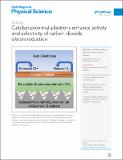Catalyst-proximal plastrons enhance activity and selectivity of carbon dioxide electroreduction
Author(s)
Khan, Sami; Hwang, Jonathan; Horn, Yang-Shao; Varanasi, Kripa K
DownloadPublished version (2.714Mb)
Publisher with Creative Commons License
Publisher with Creative Commons License
Creative Commons Attribution
Terms of use
Metadata
Show full item recordAbstract
© 2020 The Author(s) Electrochemical reduction of carbon dioxide (CO2RR) is an attractive approach toward converting CO2 to solar fuels. Novel catalyst chemistries and morphologies may provide high selectivity to both one-carbon (C1) and two-carbon (C2) products over hydrogen; however, the limited aqueous solubility of CO2 restricts the CO2RR current density. Here, we demonstrate how gasphilic bubble-trap surfaces enhance mass transfer and enrich and maintain CO2 concentration during CO2RR by forming a catalyst-proximal plastron layer, consequently increasing the CO2RR activity on both smooth and nanostructured copper as compared to the conventional headspace or bubbling modes of CO2 delivery. The H2 Faradaic efficiency is suppressed from 33% to 13% on smooth copper and from 62% to 33% on nanostructured copper, accompanied by enhanced formation of C2+ products, including ethylene, propanol, and ethanol, and >1% acetone and acetate. We highlight the importance of the catalyst-proximal plastron approach by comparing against recent aqueous-phase CO2RR studies. Khan et al. report how bubble-capturing surfaces can enhance electrocatalytic reduction of CO2 by local supersaturation of CO2 in the electrolyte near the catalyst, overcoming mass transport limitations. Thereby, hydrogen co-evolution is suppressed and formation of attractive C2+ products, such as ethanol and ethylene, is increased.
Date issued
2021Department
Massachusetts Institute of Technology. Department of Materials Science and Engineering; Massachusetts Institute of Technology. Department of Mechanical EngineeringJournal
Cell Reports Physical Science
Publisher
Elsevier BV
Citation
Khan, Sami, Hwang, Jonathan, Horn, Yang-Shao and Varanasi, Kripa K. 2021. "Catalyst-proximal plastrons enhance activity and selectivity of carbon dioxide electroreduction." Cell Reports Physical Science, 2 (2).
Version: Final published version